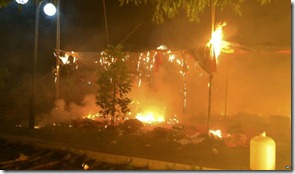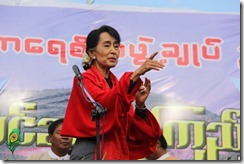Over recent weeks, events around the Letpadaung copper mine near Monywa have sent shockwaves through Burma’s fragile reform process. For months local people including Buddhist monks, had been demonstrating against the environmental damage and land seizures associated with the operation- a joint venture between a Chinese company and another owned by the Burmese military. Then, in the early hours of 29 November, riot police swarmed into the protest-camps, setting them on fire and injuring dozens of civilians.
For months local people including Buddhist monks, had been demonstrating against the environmental damage and land seizures associated with the operation- a joint venture between a Chinese company and another owned by the Burmese military. Then, in the early hours of 29 November, riot police swarmed into the protest-camps, setting them on fire and injuring dozens of civilians.
In the ensuing days, a number of those who had escaped hospitalisation were held on charges of illegal demonstration, whilst across the country prominent activists such as U-Gambira were rounded up in an apparent attempt to stem the spread of solidarity protests.
The whole incident reflects the continuing absence of rule of law in Burma; which alongside the military abuses in Kachin state and the state-sponsored sectarian violence in Arakan state, presents a stark reminder that the worldwide embrace of President Thein Sein’s administration may have been somewhat over-enthusiastic.
The President was last month recognised alongside Aung San Suu Kyi as Foreign Policy Magazine’s top political thinker of 2012. And having recently visited Washington at the invitation of Barak Obama, he will return to the US next year to receive the International Crisis Group’s eminent In Pursuit of Peace Award at a lavish ceremony in New York. The ex-general will also be jet-setting to London, as part of a rapidly blossoming friendship that this week saw the first UK trade delegation to arrive in Rangoon for decades.

They are right of course, yet at the same time it would be naive to overlook aspects of the saga that demonstrate just how far Burma has come. For whilst images of burnt monks on hospital beds naturally stir up memories of the crackdown against the Saffron Revolution in 2007, the differences between the two situations could not be more significant.
Back then the military regime massacred people on the streets without even a cursory nod to due process; but following the violence of 29 November Thein Sein’s administration set up a commission of inquiry and placed none other than Aung San  Suu Kyi in the Chair. The authorities also heeded her request for a formal apology, undoubtedly in part out of fear that solidarity protests would escalate, but nonetheless illustrating a more conciliatory approach to the propaganda and lies of five years ago. The overall situation is therefore not so much a clear-cut illustration that nothing has changed, but rather a continuation of the complex and messy governance that has characterised the reform process so far.
Suu Kyi in the Chair. The authorities also heeded her request for a formal apology, undoubtedly in part out of fear that solidarity protests would escalate, but nonetheless illustrating a more conciliatory approach to the propaganda and lies of five years ago. The overall situation is therefore not so much a clear-cut illustration that nothing has changed, but rather a continuation of the complex and messy governance that has characterised the reform process so far.
The cold hard fact remains that Burma is nowhere near democracy and the abuses taking place across the country on a daily basis should be judged against basic human rights norms, not merely in comparison to the more flagrant violations of previous governments. This means that Thein Sein must be held to account for the attacks on protestors and the ethnic pogroms in Burma, not sycophantically lauded as a reformist hero just because he is less tyrannical than his genocidal predecessors.
However, despite the on-going abuses activists should resist the temptation of completely writing-off this administration’s reformist credentials. In just a few short years Aung San Suu Kyi has gone from being a political prisoner held in near total isolation, to chairing an inquiry into the government’s behaviour in front of both Burmese and international media. Developments like that were previously unthinkable and there are undoubtedly many people waiting in the wings of the government who would like to take Burma back there. Balancing scrutiny and encouragement of the more reform-minded elements will be hard, but it is essential.


